Unscrambling the Alphabet Soup of Solar Terminology
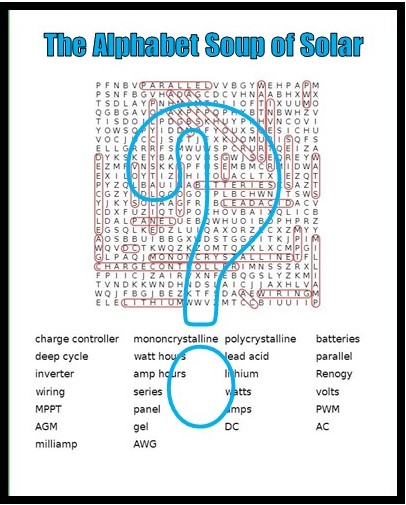
If the title of this article just made your head spin, you’ve landed in the right place -- bookmark this blog now and keep reading! As educators, we know that language can either deter or enhance learning. The language we use to describe solar energy, and electricity in general, is necessary to understand its functionality. The common terms, and alphabet soup of acronyms, can be bandied about without a shred of awareness by those familiar with them -- leaving those who don’t know what “PWM” and “MPPT” are feeling clueless, which often shuts down learning. And, honestly, knowing what the acronym itself means probably won’t help you understand what it actually does! We’ll get to that in a bit. Just like other industry’s lingo, there are those on the inside and those on the outside.
Despite solar technology being over 140 years old and many people and businesses around the globe using it for decades, it is still relatively new to the average consumer. While most people understand that it works, they may not get HOW it works. Over the years of explaining it to people, we’ve found that terminology can be the biggest stumbling block. Trust us, we were there in 2010 when we were renovating our vintage camper and wanted to install a solar powered system. There was precious little available to those of us without a Physics or Electrical Engineering degree. But, with the help of some friends in the industry, we have lived mobile with solar since 2012 and have educated a ton of people along the way!
In this article, we try to bridge the divide between the two sides of the solar electricity knowledge gap. People want to boondock with their RV off-grid without having to run a generator, but it’s the terms and lack of experience with it that is getting in the way. So, take the first step with us, learn some new terms, and start your journey here!
Renogy: What’s in a Name?
As solar ambassadors, we’ve heard the company we represent referred to as Renology and Renergy, and possibly a few others. In coming up with a name for her company, Yi Li struck on a concept that her renewable energy business would need to thrive in the rapidly changing 21st century – innovation. Thus, the name Renogy was born in 2010 -- REnewable, inNOvative, enerGY.
So, what does “renewable” energy really mean? It’s a simple concept. It’s energy that can be created (or renewed) during a typical human lifespan of 80-100 years. The sun shines and the wind blows almost everyday -- no time is needed to renew it, it cannot be depleted, and it’s just our job to capture it. All renewable energy is drawn from natural, carbon neutral sources: sun, wind, rain, tides, waves, and geothermal heat. Conversely, fossil fuels can take hundreds to thousands of years to create, and can be depleted.
Can You Name the Two Types of Electricity?
Let’s start off by talking AC/DC – not the popular Aussie band from the 80’s – but the different types of current flowing through an electrical system. If you can master the differences between Alternating Current and Direct Current, and figure out how to wire them both into your system, you are well on your way to becoming a Solar Rockstar!
Direct Current (DC) = current that flows in one direction within a circuit from source to appliance, just like water, from a place of higher pressure to lower. Solar panels and batteries create, store, and release DC current only. A great analogy borrowed from Will Prowse, is that DC power is like a river.
Alternating Current (AC) = current that vibrates back and forth from the source to the appliance all along the circuit. It is the type of current that connects to our houses, and powers a standard household outlet. Anything with the typical 2 or 3 prong plug needs AC in order to work. In Will’s analogy, AC power is not like a river, but rather like a wave in the ocean where the force of the energy moves but the water itself does not.
Just a note about why there are two types of current. In addition to other factors, AC power is better at being transported across vast distances than DC because of transmission loss. Since our national electrical grid has been set up in a regional mass production model rather than a smaller-scale local production model, AC performs better in this system.
Transmission Loss = the loss of energy that happens when electricity travels through a wire. Because electrical power needs to travel through a medium to get from one place to another, we use copper (or other form of metal) wire. For the purposes of a small-scale solar powered system, minimizing length of transmission wire or increasing wire diameter can reduce this.
Polarity = the proper flow of DC current through the system. Any component in an DC system will have a positive and negative terminal, like a battery. Reversing the polarity, hooking a positive terminal up to a negative terminal and vice versa can damage the equipment, though most of Renogy’s components are protected against improper polarity connections. There are occasions when you might want to connect batteries or solar panels in this way, see Series below.
Common Terms to Learn: Units Used to Measure Different Aspects of Electricity
Ok, ready to learn the terminology so that you can dive into creating your own system? We are going to share some analogies that are sure to help you get your head above water in no time.
Voltage/Volts (V) = a unit used to measure the pressure of the electrical system. We often use water as an analogy to understand electricity. If we were talking about a common household shower, Volts would measure the pressure of the water in the system coming to the shower head.
Amperage/Amperes/Amps (A) = a unit used to measure the flow of the electrical current in the system. Back to our shower head analogy, if the Volts is pressure, Amps measures flow of water through the shower head in gallons or liters per minute.
Wattage/Watts (W) = the product of Volts and Amps (W = V x A). The unit used to measure the work completed by the electrical system. In the analogy, this would be how well (or how satisfying) the shower head worked at getting you clean.
Watt Hours (Wh) = the length of time, in hours, that the system can do work at a given rate. In the shower, the length of time that you could take a shower at the same pressure and flow.
Amp Hours (Ah) or Milliamp Hours (mAh) = the number of Amps that you can expect a battery to provide in 1 hour at its nominal Voltage (e.g., 12V). Amps x Hours = Amp Hours (Ah)
For example, a 50 Ah deep cycle battery can provide 50A for 1 hour or a 1A for 50 hours. In shower terminology, you could have the shower of your dreams (probably enough to remove a tattoo) for 1 hour or stand under a trickle for about 2 days. Note: Smaller, portable batteries are rated in Milliamp Hours (mAh), 50Ah = 50,000 mAh. The use of Ah vs mAh is simply to distinguish between the common applications for each type. Renogy’s line of portable E. POWER Solar Chargers are rated in mAh and are designed to throw in a purse, backpack, take on an airplane, etc.
Important Equations to Learn: Used to Determine the Size of System YOU Need
We emphasize the YOU in this title because every single person / household has different energy needs. Some people have an electric stove, others use gas. Some people shower and do dishes with hot water every single day, others prefer to wipe them clean and wash every few days. Some people watch 8 hours of TV per day, others never turn it on except to watch a movie occasionally. To design a solar powered system that meets YOUR needs, you need to do a bit of an energy audit for YOUR household.
Volts x Amps = Watts
Let’s say you are determining how large of a system you need for your rig or off-grid cabin. The very first step is to figure out how many
Watts each of your appliances requires. While most AC appliances are listed in Watts, many 12V DC appliances just list the Amps because they assume you know it’s a 12V appliance. Let’s say that you know the Amps required by an appliance, but need to determine the Watts. What would you do?
• Fantastic Fan: 12 V x 1.9A = 22.8W
• LED Light Strip / Bulb: 12 V x .667A = 8WRemember: If you have more than one light strip or lightbulb, multiply the Watts by the number you have in your rig/cabin (e.g., 3 light strips x 8W = 24W).
If you can’t find the label on a specific appliance, use this Wattage Chart for Typical RV Appliances. Caution: You’ll find that some appliances have a wide range for wattage based on their size and capacity, so it’s always best to determine the watts of YOUR appliances.
Watts x Hours = Watt Hours (Wh)
Ok, now you’ve figured out how many
Watts each appliance requires to run. Now, you need to figure out your TOTAL Watt Hours in order to determine the size your system should be based on your personal energy needs. With the Watts for each appliance at hand, you simply multiply the Watts for each appliance x the Hours you typically use EACH appliance EACH day.
• Fan: 22.8 W x 4 hours = 91.2Wh
• Lights: 16 W x 5 hours = 90Wh
• Laptop: 65 W x 2 hours = 130WhEnergy saving tip! If you are using your device while charging it, it will use a lot more Watts than if you turn it off and let it recharge.
Add all these Wh numbers up, and you have YOUR magic number which will help you choose which components that you need to purchase. Use this Solar Calculator to determine the number and type of components you need.
Why Do You Need to Understand These Terms?
The 4 different components of a solar powered system are rated in these different units mentioned above. This isn’t designed to confuse you, rather it describes what each specific component model can do and to what limit. Let’s dive back in…
Solar Panels are rated in Watts (W), because they produce an electrical current that is capable of doing electrical work. You can run an appliance directly from a solar panel should you want to, though most off-grid systems involve storing that energy in a battery to do work at a later time (when it’s dark, cloudy, raining, etc.). The Watts of a specific solar panel (e.g., 100W, 200W, 300W) will indicate the maximum power output of that panel under optimal solar conditions. Note: You will not see this power output measured in your system, because of the 5% - 10% transmission loss along the wire connecting the panel to your charge controller.
Solar panels come in various styles and are made out of different types of solar cells – polycrystalline and monocrystalline:
• Polycrystalline = older, less expensive, and less efficient cells.
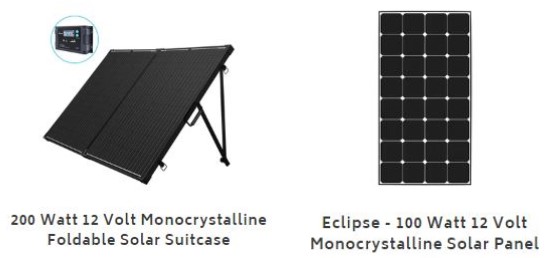
• Monocrystalline = newer, more expensive, but more efficient cells that can produce more Watts per cell. Note: Renogy’s “Eclipse” line is most efficient, giving you a smaller panel footprint for the same wattage.
Charge Controllers are rated in Amps (A), because they manage the charging current going from the panels to the batteries and keep it in check. In simple terms, they serve as the brain of the system! The specific rating (e.g., 10A, 20A, 30A…100A) is the upper limit of the current that the controller can handle without damage or tripping the fuse.
Charge controllers are made with different types of technology -- PWM stands for Pulse Width Modulation and MPPT stands for Maximum Power Point Tracking. Does that clear it up for you? We didn’t think so. These are terms that engineers use to distinguish how they work internally, but typically means nothing to the average consumer. That’s where we come in!

• PWM = a simple switch that allows the current coming from your panel to come in at a just slightly higher voltage than the battery status, modulating back and forth, and then shutting off when the battery is full.
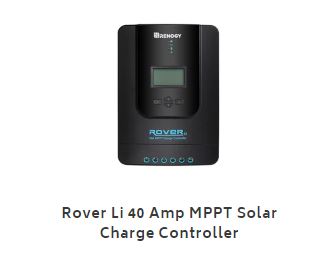
• MPPT = more complex internal components that track the Amps and Volts coming from the panel to maximize what the battery needs at any given time throughout the charging cycle. They also employ a heat sink within the unit that captures additional power, helping to maintain a more constant flow of energy when other conditions affect performance (e.g., clouds, sun angle, temperature, etc.)
Overall, MPPT can increase the efficiency of a system by 10-45%, depending on the time of year and solar conditions; but, can be significantly more expensive than PWM controllers and typically only pay off when you have a solar panel array greater than 800W.
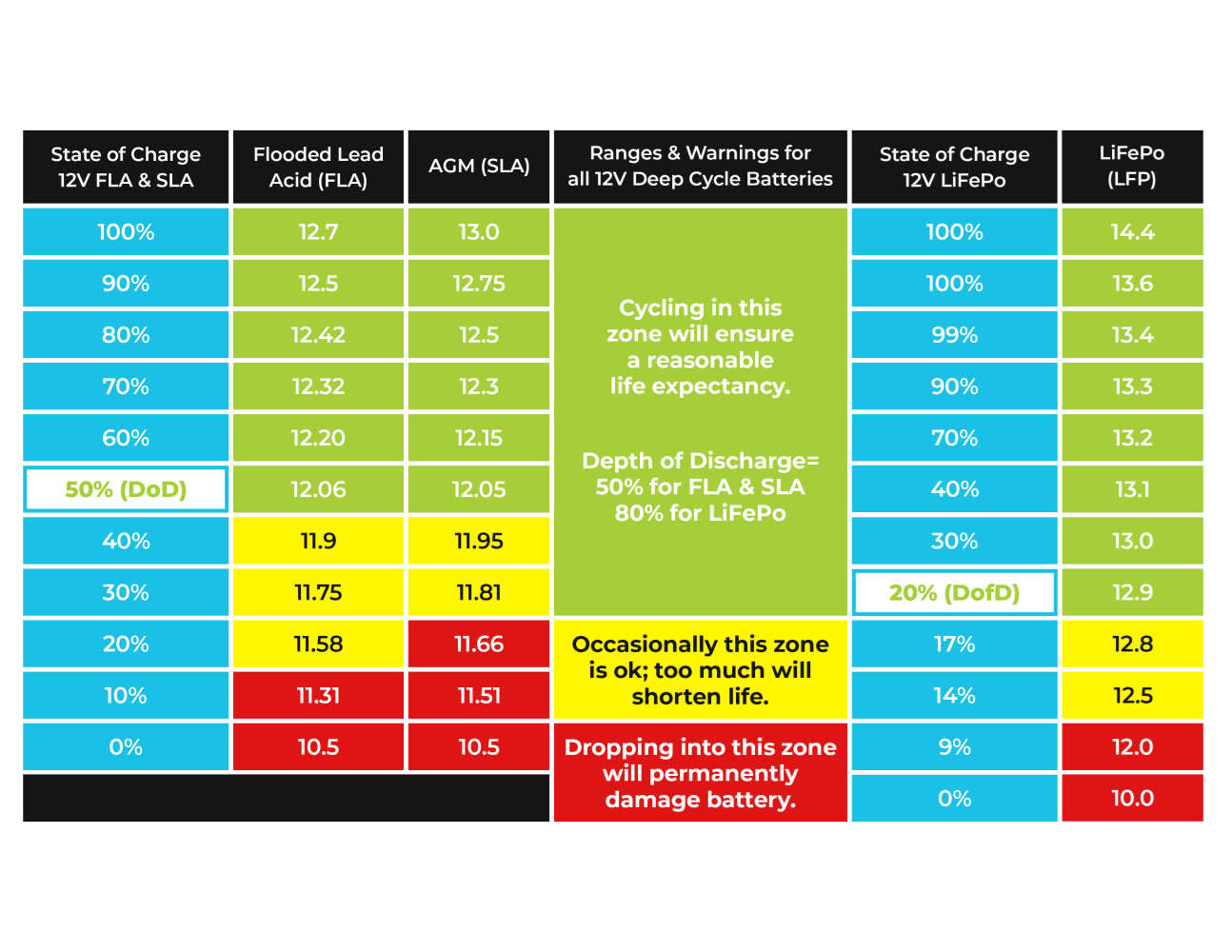
Deep Cycle Batteries come in various Voltages (6V-12V-36V-48V), but their capacity is rated in Amp Hours (Ah), so that a consumer will know the length of time they could expect a specific flow in Amps.
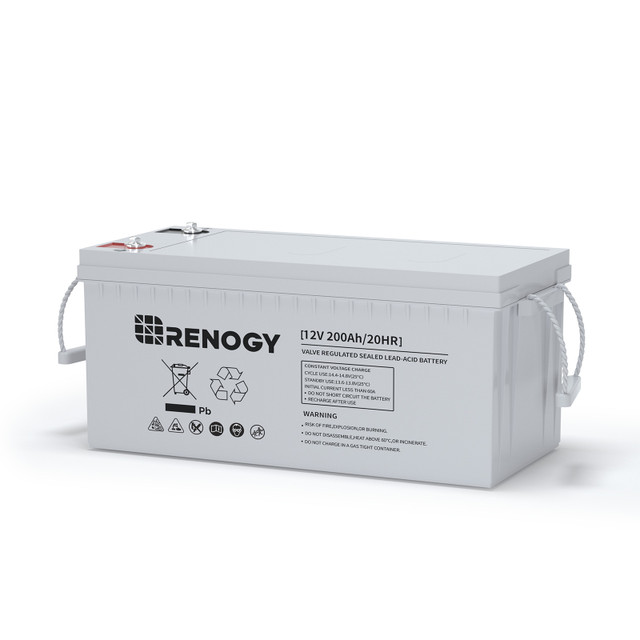
So that consumers have options for different installation situations, there are 4 types of solar deep cycle batteries: flooded lead acid, gel, AGM, and Lithium Iron Phosphate. Deep cycle batteries are designed to be discharged and charged many times over their lifespan and vary significantly with regards to their chemistry, lifespan, charging time, cycles, etc. Before investing in a battery bank, check out our recent blog for a comprehensive comparison chart of deep cycle batteries. You’ll discover that some may have an expensive price tag upfront, but may be the least expensive option in the long run! Renewable energy is designed to be a long-term investment for less money over the long haul.
Inverters are rated in Watts (W), much like solar panels because they power the outlets and appliances that require AC power rather than DC power. The rating (e.g., 700W, 1000W, 2000W, 3000W) indicates the maximum power output that an inverter can handle without damaging or tripping the fuse.
As you probably guessed, inverters come in various styles as well and have confusing terms to describe them. Here are a couple that can trip you up:
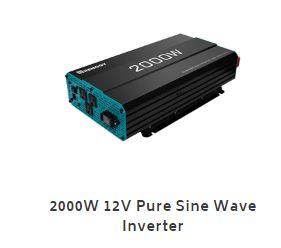
• Pure Sine Wave = designed to more closely match the “wave frequency” of Alternating Current (AC), making them more efficient.
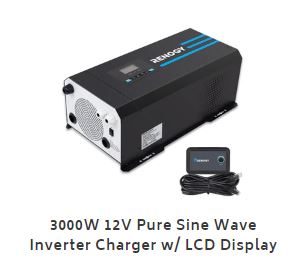
• Through Inverter / Inverter Charger = allow you to run your RV appliances AND charge your house battery at the same time when you are plugged into 110V AC shore power. This product is very helpful when you are at a campground with electrical hook-ups for a few days, then want to boondock off-grid for a week or so when sun availability is low.
Almost There! Terminology Used to Create Connections Between Components
Whew! That was a lot, but hang in there…there are some important terms used to describe how these components go together. Putting your solar panels or batteries together in two different configurations will alter the kind of system you have.
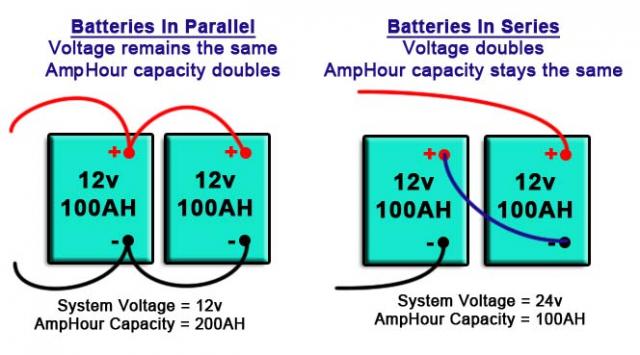
Series = linking the negative terminal of one component to the positive terminal of another. Doing this with solar panels or batteries, will increase the Voltage, but keep the Amps the same. The most common example of this will be connecting two 12V batteries together in Series, to create a 24V system with the same number of Amps. This can be done with panels as well, two 12V panels connected in Series will produce 24V going to the Charge Controller at the same number of Amps as just one panel.
Parallel = linking the positive terminal of one component to the positive terminal of another, while also linking the negative terminals or going to a common ground. This is the opposite of linking panels and batteries in Series -- connecting this way will double the Amps while keeping the Voltage the same.
Why is this important? Just like how higher water pressure helps transport water over a longer distance, higher Voltage DC systems help transmit power over longer distances. With the pressure (Voltage) higher and the current (Amperage) the same, we can use the same size (gauge) wire to transmit the power. Since larger gauge wire is expensive, a higher Voltage system can save you money in the long run (pun intended!).
But this isn’t the whole story, having a higher Voltage system means that you’ll need to step the voltage down to be able to run many 12V appliances in your RV, van, or off-grid cabin. While more variable voltage appliances are being made, especially in electronics, there still aren’t a lot of options at this point.
AWG = stands for American Wire Gauge and is the standard scale on which all conductive wire is measured. Rather than describe the wire as being 0.036 inches in diameter, we refer to it as 20 gauge, or 20 AWG. The scale was set up so that the lower the gauge number the thicker the wire is – so 18 gauge is thicker than 20 which is thicker than 22. The thicker the wire, the bigger the current load it can carry without overheating. But thicker is more expensive and heavier per linear foot.
Fuse = a piece of metal (usually surrounded by an insulating material) that protects the wire in a circuit from overheating, by melting at a lower current for which the wire is rated. Fuses are inexpensive, easy to replace, and prevent damage or fires that could be started by a melting wire. In general, a good rule of thumb is to protect every wire in your system with a fuse. If you plan to run 20A through a given wire, you should install a 20A (or less) fuse to protect it. Going lower than 15A could provide more protection for the wire, but could cause it to trip unnecessarily depending on the appliances being used.
Circuit Breaker = an internal switch mechanism that can be tripped by an unsafe electrical surge and can be reset. These are utilized with higher wattage appliances and contained in a breaker box, like in your traditional home.
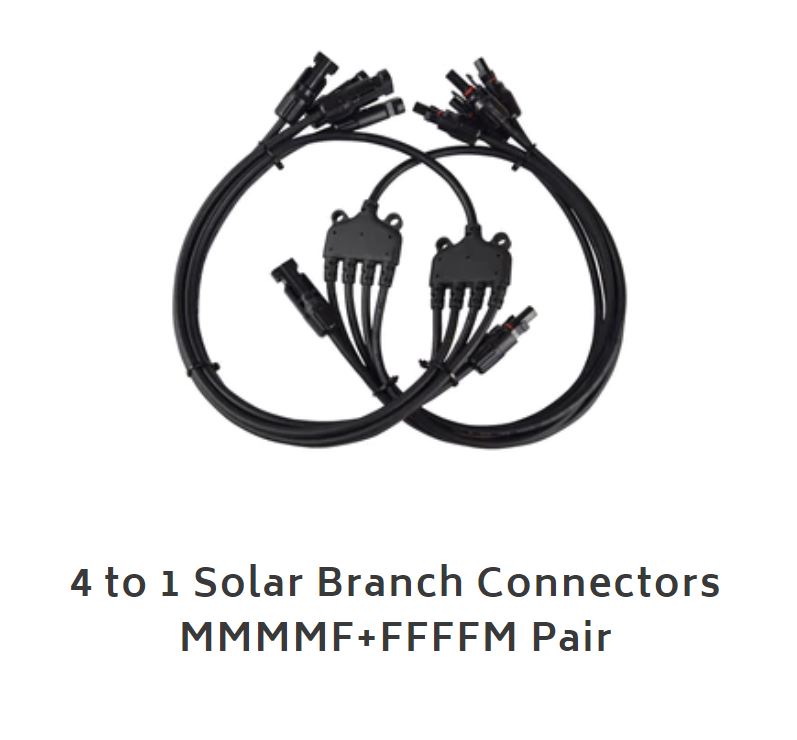
Solar Branch Connectors / MC4 Connectors = standardized connectors that allow you to attach solar panels in Series or Parallel or simply to add an extension cord. MC4’s can be repeatedly connected and disconnected. For example, when using a portable panel that is stored inside your vehicle while driving and set out when parked, you will connect/disconnect it at the MC4 connection point.
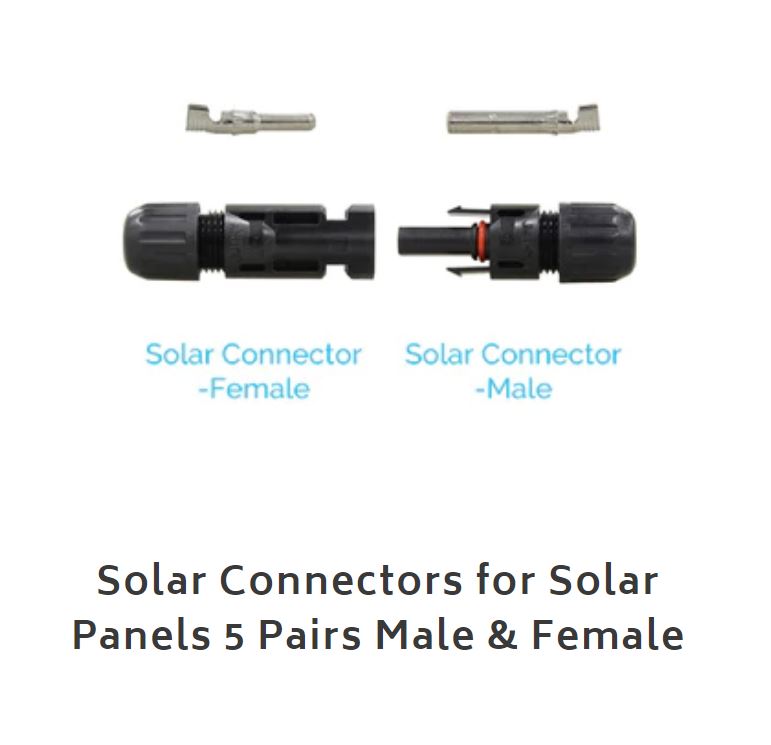
Do you feel ready to talk shop like the pros or be the smartest person at your next RV socially distant gathering? Like any new skill set or knowledge, repetition, practice, and patience are the keys to becoming more comfortable with living a solar powered lifestyle. Ten years ago, we had no practical experience with this terminology…and now we’re teaching it. If we can do it, so can you!
If you need further explanation or help with troubleshooting your solar installation, give us a shout. We are educators by trade and love to help people get started with solar. If we don’t know the answers, we’ll get in touch with our Renogy Engineer friends. Please contact us via our website or social media listed below.
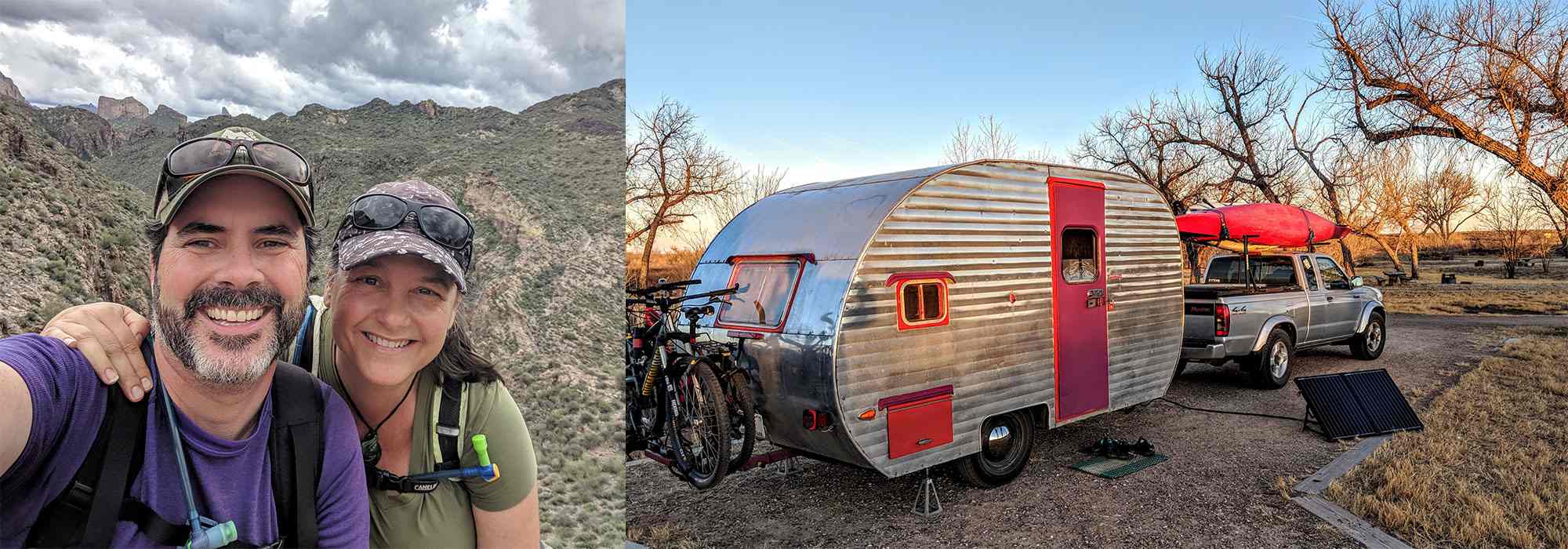
Shari Galiardi & David Hutchison have turned their higher education backgrounds, desire for life-long learning, and thirst for adventure travel into writing, photography, video production, and public speaking tours from coast to coast. Known to their friends as simply Shari & Hutch, you can learn more about their full-time, solar powered adventures on their website at freedominacan.com. Or, follow them on Facebook, Instagram, and YouTube as “Freedom in a Can.”








